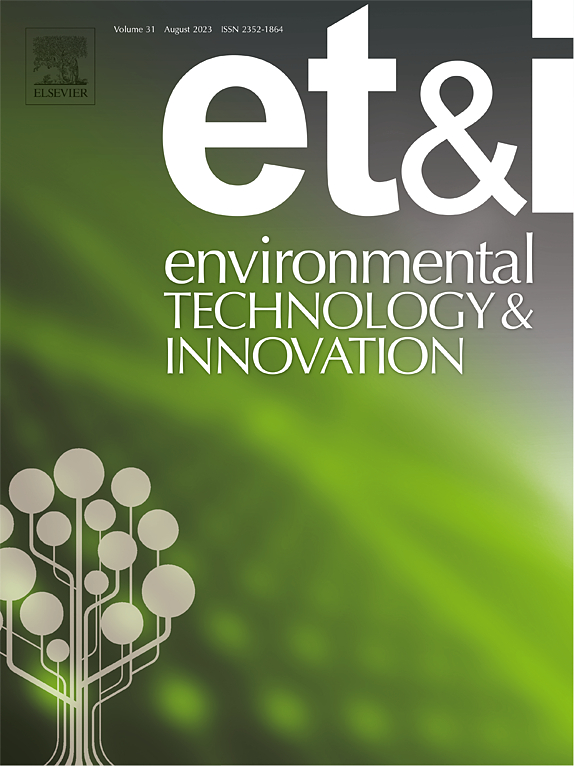利用代谢组学和离子组学阐明铝在小鼠器官中的毒性
IF 6.7
2区 环境科学与生态学
Q1 BIOTECHNOLOGY & APPLIED MICROBIOLOGY
引用次数: 0
摘要
铝是一种广泛存在的环境污染物,已被证实对人体多个器官具有毒性作用。为了全面了解这些毒性作用及其机制,本研究旨在通过代谢组学和离子组学分析评估代谢物和离子数据之间的潜在相关性。我们试图探索铝对小鼠各种器官的复杂影响。采用气相色谱-质谱联用(GC-MS)和电感耦合等离子体质谱联用(ICP-MS)对对照组和铝暴露小鼠的海马、皮质、心、肝、脾、肺、肾、骨、肠、胃和血清进行代谢组学和基因组学分析。并进行组织学检查和行为学实验。多变量分析揭示了91种不同器官的差异代谢物,主要包括氨基酸、脂肪酸和碳水化合物。所涉及的异常代谢途径包括氨基酸代谢、花生四烯酸代谢和谷胱甘肽代谢。此外,在不同器官中观察到锰、锌、硒、铁、铜、磷、镁和钙等离子的动态平衡变化,可能影响关键酶的活性。这些潜在生物标志物和离子的变化表明,铝暴露的毒性机制包括氧化应激、炎症反应、细胞信号失调、关键酶活性破坏和能量代谢受损。本研究为了解铝暴露的毒性机制提供了一个新的视角,可能有助于铝中毒的预防和治疗。本文章由计算机程序翻译,如有差异,请以英文原文为准。
Leveraging metabolomics and ionomics to illuminate aluminum-induced toxicity in mouse organs
Aluminum, a widely prevalent environmental pollutant, has been established to exert toxic effects on multiple organs in the human body. To gain a comprehensive understanding of these toxic effects and the mechanisms involved, this study aimed to assess potential correlations between metabolites and ion data through metabolomic and ionomic analyses. We sought to explore the intricate impact of aluminum on various organs in mice. Gas chromatography-mass spectrometry (GC-MS) and inductively coupled plasma-mass spectrometry (ICP-MS) were employed to conduct metabolomic and ionomic analyses on the hippocampus, cortex, heart, liver, spleen, lung, kidney, bone, intestine, stomach, and serum of both control and aluminum-exposed mice. Besides, histological examinations and behavioral experiments were conducted. Multivariate analysis revealed 91 differential metabolites across various organs, primarily encompassing amino acids, fatty acids, and carbohydrates. The implicated abnormal metabolic pathways included amino acid metabolism, arachidonic acid metabolism, and glutathione metabolism. Additionally, alterations in the homeostasis of ions such as manganese, zinc, selenium, iron, copper, phosphorus, magnesium, and calcium were observed in various organs, potentially influencing the activity of critical enzymes. The changes in these potential biomarkers and ions suggest toxic mechanisms of aluminum exposure involving oxidative stress, inflammatory responses, cellular signal dysregulation, disruption of key enzyme activities, and impaired energy metabolism. This study provides a novel perspective on understanding the toxic mechanisms of aluminum exposure, potentially contributing to the prevention and treatment of aluminum toxicity.
求助全文
通过发布文献求助,成功后即可免费获取论文全文。
去求助
来源期刊

Environmental Technology & Innovation
Environmental Science-General Environmental Science
CiteScore
14.00
自引率
4.20%
发文量
435
审稿时长
74 days
期刊介绍:
Environmental Technology & Innovation adopts a challenge-oriented approach to solutions by integrating natural sciences to promote a sustainable future. The journal aims to foster the creation and development of innovative products, technologies, and ideas that enhance the environment, with impacts across soil, air, water, and food in rural and urban areas.
As a platform for disseminating scientific evidence for environmental protection and sustainable development, the journal emphasizes fundamental science, methodologies, tools, techniques, and policy considerations. It emphasizes the importance of science and technology in environmental benefits, including smarter, cleaner technologies for environmental protection, more efficient resource processing methods, and the evidence supporting their effectiveness.
 求助内容:
求助内容: 应助结果提醒方式:
应助结果提醒方式:


